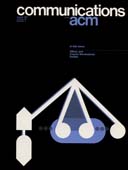August 1981 - Vol. 24 No. 8

Features
The factors underlying system design for usability are examined and the role and responsibilities of a usability committee described. Under the control of a usability committee, a balance between high levels of system function and usability was reached for the IBM System/38. The System/38 command language is presented to illustrate this balance.
Mxec: parallel processing with an advanced macro facility
Mxec is a sophisticated computing environment (executive system) which extends and magnifies users' interactions with a computer. Principally, Mxec provides for parallel processing and also assumes many of the mundane, clerical tasks with which users of most systems find themselves burdened. Some of the characteristics of the Mxec system are given, and its motivation and implementation are discussed.
Psychology of calculator languages: a framework for describing differences in users' knowledge
This paper presents a framework for describing users' knowledge of how a simple four-function calculator operates. Differences among novices and experts in their conceptions of “what goes on inside the calculator” for various sequences of button presses are summarized. Individual differences include different views on when an expression is evaluated, different procedures for evaluating a chain of arithmetic, and different rules for evaluating unusual sequences of key presses.
Long term file migration: development and evaluation of algorithms
The steady increase in the power and complexity of modern computer systems has encouraged the implementation of automatic file migration systems which move files dynamically between mass storage devices and disk in response to user reference patterns. Using information describing 13 months of user disk data set file references, we develop and evaluate (replacement) algorithms for the selection of files to be moved from disk to mass storage. Our approach is general and demonstrates a general methodology for this type of problem. We find that algorithms based on both the file size and the time since the file was last used work well. The best realizable algorithms tested condition on the empirical distribution of the times between file references. Acceptable results are also obtained by selecting for replacement that file whose size times time to most recent reference is maximal. Comparisons are made with a number of standard algorithms developed for paging, such as Working Set, VMIN, and GOPT. Sufficient information (parameter values, fitted equations) is provided so that our algorithms may be easily implemented on other systems.
Timestamps in key distribution protocols
The distribution of keys in a computer network using single key or public key encryption is discussed. We consider the possibility that communication keys may be compromised, and show that key distribution protocols with timestamps prevent replays of compromised keys. The timestamps have the additional benefit of replacing a two-step handshake.



